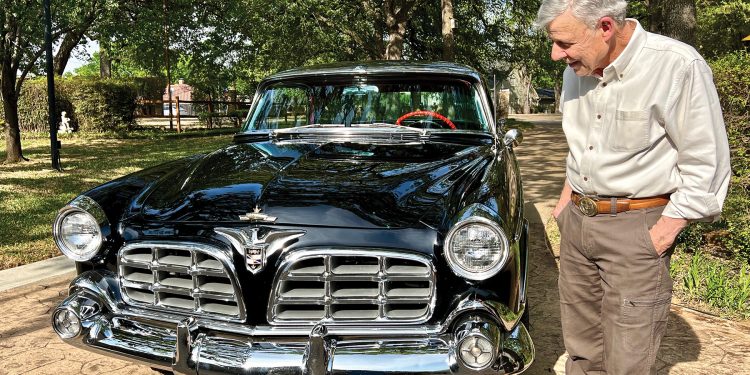Arlington classic car collector, Mike Ames, has had his eye on this “purest of the Imperial years,” when the Chrysler Corporation in 1955 finally had introduced a premium marque to take on Cadillac and Lincoln.
This car spent most of its years in Honolulu with its original owner, a lady who had been given the choice of either a Cadillac Coupe de Ville or this custom Imperial Newport.
In a 2008 feature story in an Imperial newsletter, she said there was no question of what she wanted. She liked it because it was different, and, as her daily driver, it was just one of only five Imperials in Hawaii.
“Later it made its way across the Pacific to California and into the hands of one of my fellow collector friends. I finally convinced him to sell it to me, and it became the latest to join the line up in my garage,” Mike explains with a big grin.
“The dramatic, lavish design with the brilliant 331-cubic-inch Hemi-Head V8 engine and faithfully restored to showroom quality, it’s among the finer examples of a stand-alone make that Chrysler produced for 20 years.
“The ’55 is considered the purest of the Imperial years with gun-sight taillights, the massive split grill, full-round wheel openings and tastefully applied chrome everywhere. That it has only 58,533 miles on the odometer is a real bonus, and it drives like a dream.”
Mike’s use of superlatives in describing his Imperial seems entirely justified when we see how the luxurious, top-of-the-line vehicle was launched with the claim by its manufacturer as “The Finest Car America Has Yet Produced.”
The brochure goes on to announce that the Imperial was a completely new motorcar – restyled from road to roof and from end to end – literally, inside and outside, everything is new. Anticipating the nature of its owners – men and women who, able to afford the finest of all motorcars – Chrysler believed they would find performance of incomparable excellence. Even standing still, the designers boasted, the superbly beautiful new car had the dynamic look of forward motion.
Perhaps the most dramatic of its appearance in comparison to every other car on the market in the mid 1950s is its massive front end. As you can see, Mike’s focus on it recognizes it as a stand-alone feature that sets it aside as much today as it did when introduced 67 years ago.
The rear bumper design follows the same motif as the front bumper. The twin exhaust ports, and the tall, arched design back-up lights are inset in the bumper and emerge from heavily chromed hoods set against the fenders, which integrate the entire unit with the balanced lines of the fenders and body.
The car’s interior had its own claim to new styling, beginning with the instrument panel sporting large, closely grouped dials, recessed knob-controls “within instant access of hand or eye.” Even the all-new “Super-Scenic” windshield with sweptback corner posts makes a significant advance over the ordinary.
That beautifully sculptured Imperial eagle-and-shield hood emblem with an emblazoned gold Imperial scroll and crown is a real stand out.
The aforementioned Gunsight taillights proclaim the dashing and distinctive character of the new model, inside door handles are mounted on a burnished plate facing forward for extra safety, and the strikingly handsome Imperial-crown medallion that is set into each quarter panel provides a “custom touch” that adds a distinctive note of elegance.
Finally, the new twin exhausts are recessed within the massive rear bumper-guards and (a bit of a secret) the actual exhaust fumes are released below the bumper to prevent any dust buildup on the shiny chrome.
We might conclude that the Imperial had thought of everything. That’s why Mike wanted one in his automobile collection. To confirm all the claims about its appearance, just taking a ride around the neighborhood does that.
Heads turn to follow the big luxury vehicle as it passes by – for most, it’s something they haven’t seen before.

















